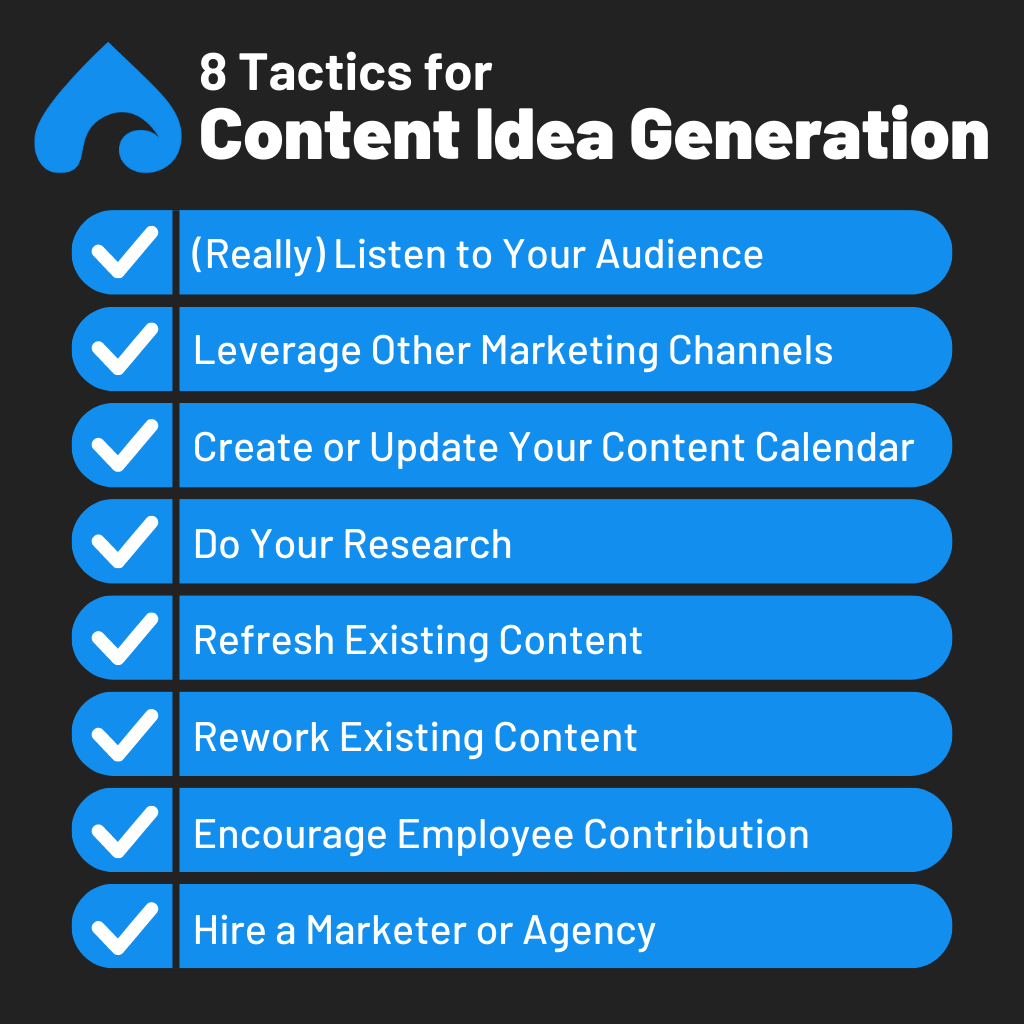“A day without content is like a year without rain…”
Okay, maybe that’s not exactly how the song goes, but a “content drought” can feel just as devastating.
The fact is, if you as the owner or CEO handle your business’s content output on your own, you risk running out of ideas. Once you do, is it the end?
Not at all. I’d say it’s just the beginning. Here’s how to create a self-perpetuating well to ensure an endless stream of content.
The Consequences of Running Out of Content
Every piece of content is another door into your site, and effective SEO places that door right under the public’s nose (i.e., on the front page of Google). But what happens when you suffer from a lack of ideas and stop uploading fresh, optimized content?
We can represent the life of an optimized piece of content with a bell curve. You may not have much engagement in the beginning, but as you gain traction and rank for the keywords you want, you can stay at the top for months or even years.
However, this is finite. As time passes, your ranking slides down on the other end due to a mix of competition and relevancy. That’s why you keep uploading new content — as one post comes down the bell curve, another comes up, solidifying your place on the front page of Google.
If you don’t add fresh content regularly, you’ll fall off the front page of Google permanently, which your competitors want — so they can steal your audience out from under your nose.
Don’t give them the satisfaction.
Why Companies Run Out of Content
“Why don’t I have any ideas?”
If you’re at the end of your rope, you’ve likely cried this to a deity before. I’m no marketing god, but there are several reasons the mental well may run dry:
- You aren’t prioritizing content production.
- You don’t understand your audience’s interests.
- You haven’t delegated to a marketing team or agency.
- You’re too close to the idea to realize it can be turned into content (more on this later).
- You don’t have a content marketing plan, or your plan is weak.
That last point may not resonate with you. Maybe you have the best content marketing plan ever created. It’s just not working anymore because a plan works until it doesn’t.
If you’re running out of ideas, it means you haven’t pivoted or updated that plan to support the next phase of your content marketing strategy. What got you here won’t get you there, or any other “there” after that.
Signs Your Content Well Is Running Dry
Maybe you believe the content ideas will always be there, but here are some signs a shortage is around the corner:
- Your content no longer resonates with your audience — your number of likes, comments, etc. is dwindling.
- You’ve gone off base and ventured beyond your original plan/content categories.
- You’ve lost motivation, and creating content feels like a chore.
If you recognize one or more of the aforementioned warning signs, don’t panic. It may seem far-fetched, but there are ways to ensure you never, ever, ever run out of content ideas — like, ever.

8 Strategies to Ensure a Stream of Relevant, High-Value Content Ideas
1. (Really) Listen to Your Audience
If you’re struggling to come up with ideas, it can be beneficial to ask your audience what they’d like to know about your area of expertise. Survey your clients, or read the comments left on your content.
Many times, you won’t have to ask your audience what they need.
In every point of contact with your clients, customers, and audience, there is an opportunity to mine content ideas — buckets of them. The problem is you’re so close to those ideas that you don’t recognize them as content fodder. It’s the curse of knowledge.
How do you break the curse?
Immediately after every client interaction, take 5 to 10 minutes to ask yourself, “What were the biggest questions the client asked? How can we answer those questions in our content strategy?” If one or two boisterous clients have asked a question, it’s probably something the rest of your quieter audience wants to know, too.
Or, maybe your clients are asking the wrong questions, but in return, you’re giving them much-needed advice. Don’t undervalue those verbal nuggets. What are you telling your clients that you haven’t talked about before on your blog/channel/social media/etc.?
Usually, those obvious insights are the best sources for content. Don’t mistake simple or obvious for worthless.
2. Leverage Other Marketing Channels
If you’ve only uploaded content to one channel, the good news is you now have well-thought-out topics, opinions, and content you can repurpose for other channels — YouTube, LinkedIn, a blog, etc.
When it comes to bringing content to new channels, I strongly believe in a slow-burn approach — mastering each channel one by one and not biting off more than you can chew. Taking the time to set a strong foundation of knowledge will aid you (and your marketing results) in the long run.
As you’re learning each new channel, look for gaps in your content marketing strategy mapped against the customer journey. There may be opportunities to create new types of content — reviews, case studies, testimonials, sales, collateral — that you can borrow from existing content. Fill in the gaps to create completely new, high-value pieces.
3. Create or Update Your Content Calendar
I’m not exaggerating when I say the success of your content marketing strategy hinges on the strength of your content calendar.
Planning content ahead of time means:
- You avoid scrambling for inspiration.
- You can work on your content on your own time, when your mind is at its best.
- You’re more organized, which is beneficial for both your business and your mental health.
- You improve uploading consistency and stay top of mind.
Each of our clients has a detailed content calendar optimized to their marketing strategy. For every piece of content, we list not only the title, but also the main topics and subheadings, if applicable. That way, our clients get a bird’s eye view of each piece at a glance.
We also include a running list of potential ideas we encourage everyone from both teams — theirs and ours — to contribute to.
4. Do Your Research
For the well to be full, you need to fill it.
Your content input is just as important as your content output. Ever heard the saying “Readers are leaders”? If you’ve gotten so busy that you’ve stopped keeping up with industry trends, don’t be surprised if your audience leaves you for a competitor who’s constantly learning.
So, refresh your content input. Create a list of industry leaders and competitors, and keep up with their content. Boom: You now have multiple constant sources of inspiration.
5. Refresh Existing Content
Look for 6- to 12-month-old posts that are losing traction and keywords to competitors (i.e., at the tail end of the bell curve). Update them using our content refresh guide, republish, and repromote. Your audience — even if they’ve read it before — could use the refresh as well.
6. Rework Existing Content
Here’s a secret: Wholly original content is rare. In fact, your favorite content creators say and resay the same things a million different times.
Take a close look at your favorite creators’ output — Gary Vaynerchuk, Ann Handley, Tim Ferriss, etc. Odds are, you hear the same lessons repeated in books, videos, blog posts, and everywhere else they publish.
Reworking existing content hits your audience at different stages. Maybe they don’t need to hear your entire 20-step guide again, but they’re stuck on step seven. You can make an entire YouTube video fleshing out step seven — and 19 others for the remaining steps.
7. Encourage Employee Contribution
If you as the owner have been the sole idea well, it may be time to tap into the wisdom of the rest of your company. Many of our clients have used this strategy successfully, and we use it ourselves.
This is the same strategy you use in the rest of your business to grow and scale. You get dangerous enough to delegate and articulate what you need, and then you teach someone else how to do it better than you.
Your team has specific knowledge, which they may be able to use to approach a topic from a completely different angle that resonates with people in your audience you’re not currently engaging.
This gets your team more involved in content creation, helps them think through and solidify ideas, and transfers authority so you’re not the bottleneck of the company. Everybody wins.
8. Hire a Marketer or Agency
If you’ve been creating content all by yourself, congratulations. But to accomplish things you’ve never achieved, you have to do things you’ve never done. If you want to ensure an endless stream of content, it’s probably time to hire a marketer or an agency.
When we partner with a business, we start with their marketing goal, the foundational concept of “what do I want to achieve?” (A lot of times, this is buried beneath “what do I want to do next?”)
We work backwards from there, take inventory of what our client has uploaded already, and figure out the best opportunities for where they want to go and how to get there.
Any agency worth their salt will do something similar.

Final Thoughts on Dry Content Wells
Fresh out of content ideas? This isn’t the end of your content output. Rather, it’s the end of a chapter.
What do you want the next chapter of your content marketing strategy to look like? While you’re deciding, stay open to new ideas and new ways of doing things. It can be helpful to encourage your audience to chime in on which strategy might best serve their current needs.
Follow the tips above, and your well of content ideas will become a self-perpetuating fountain.



